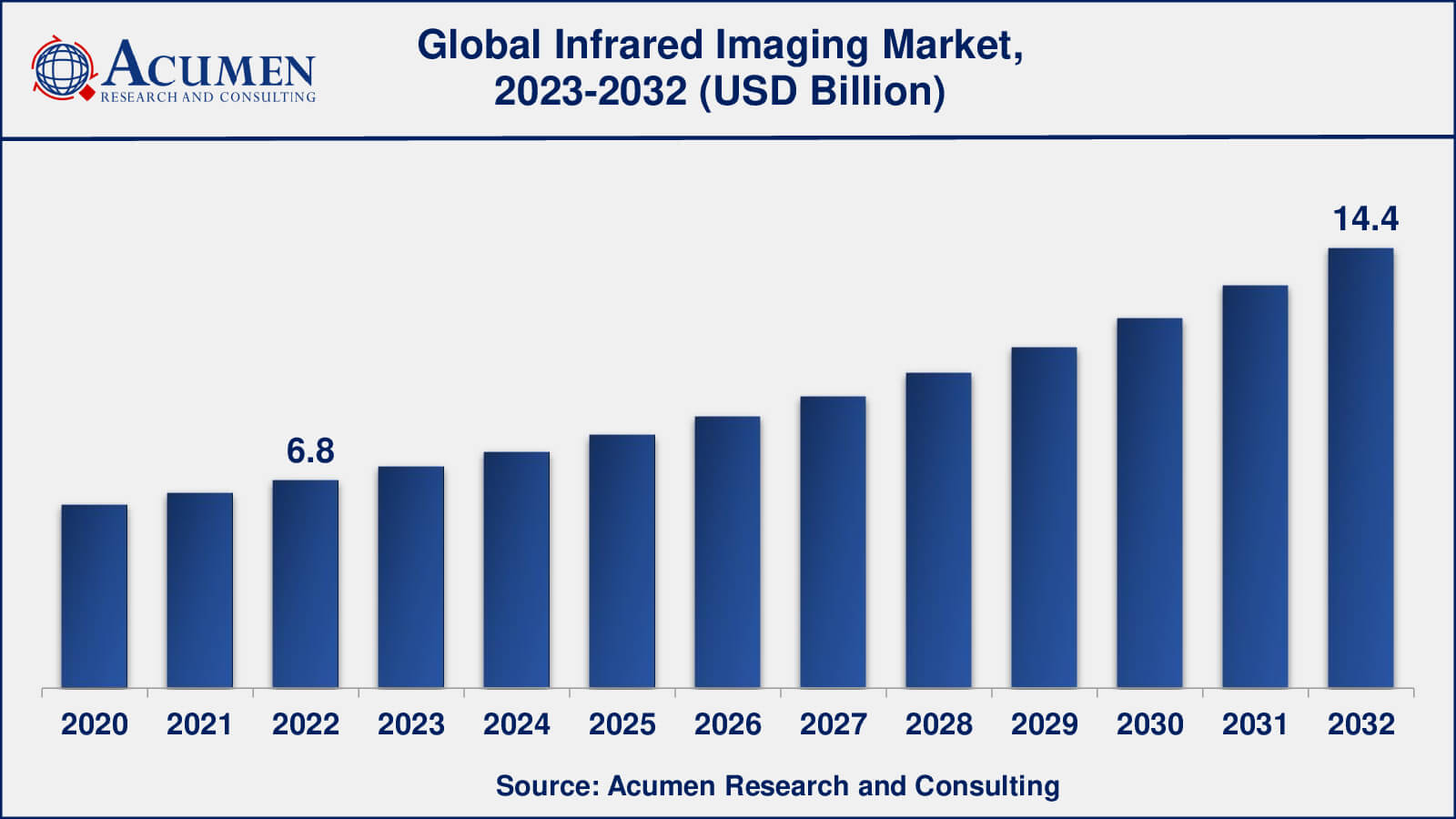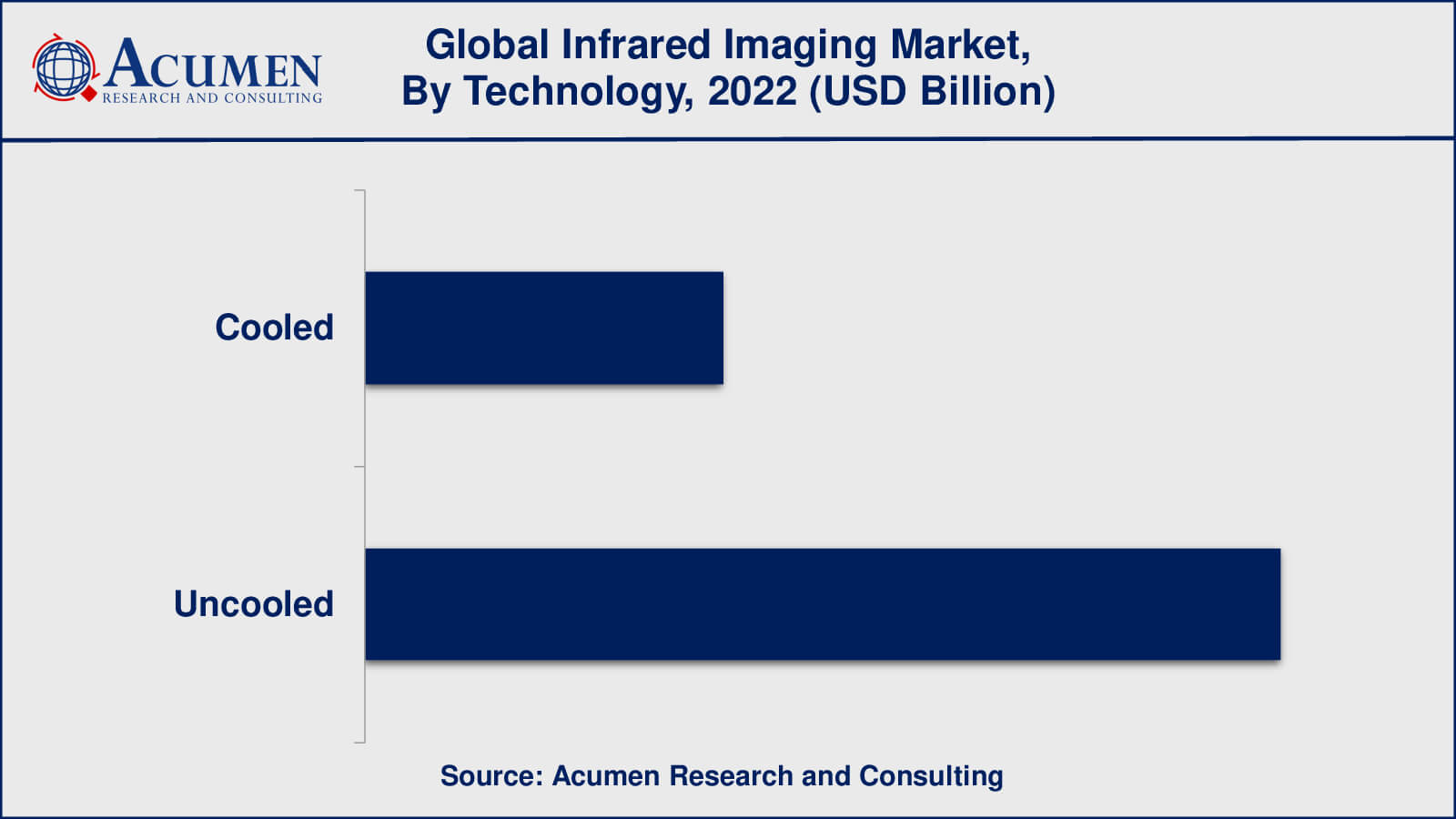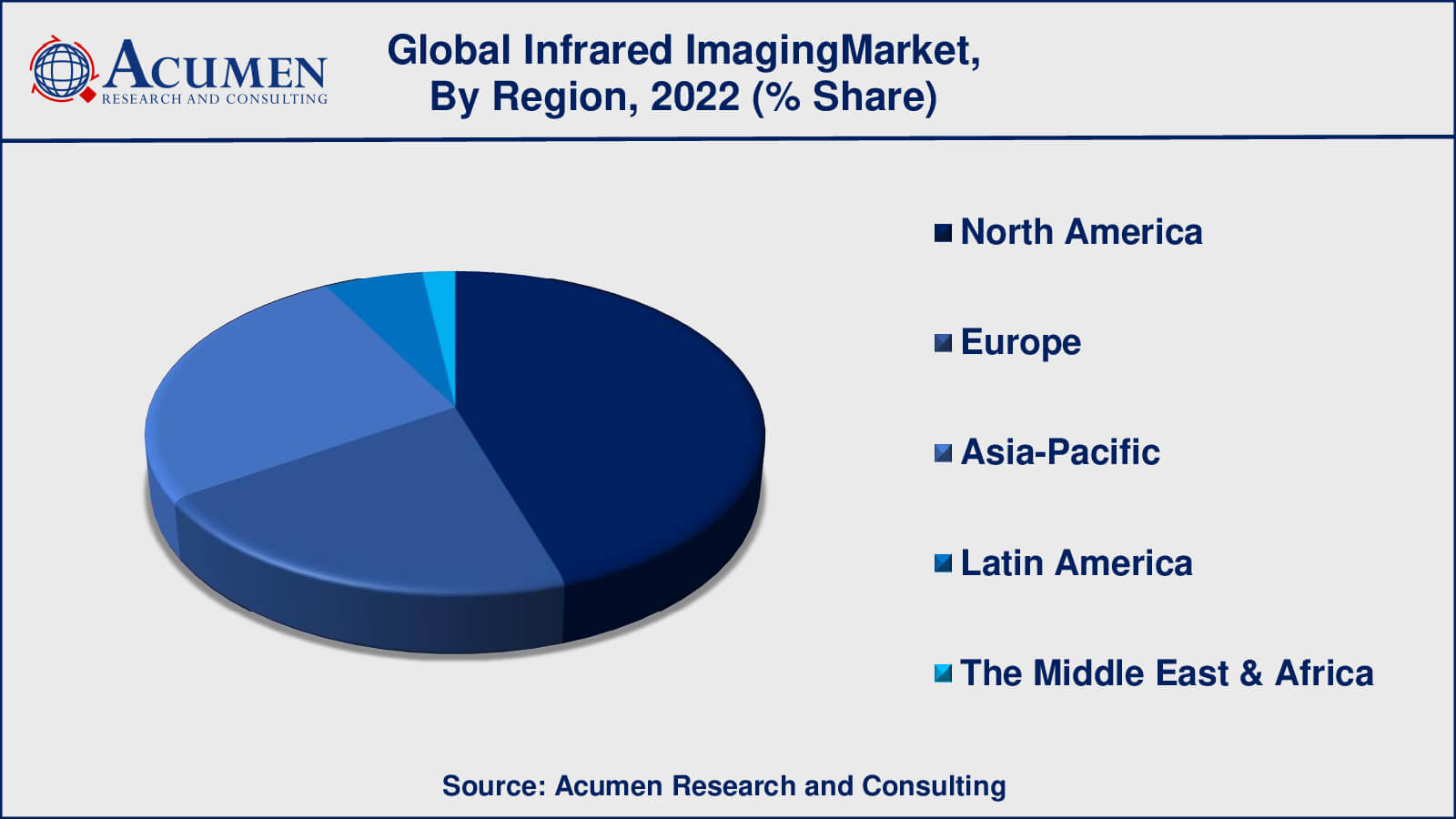Infrared Imaging Market Size - Global Industry, Share, Analysis, Trends and Forecast 2023 � 2032
Published :
Report ID:
Pages :
Format :
Infrared Imaging Market Size - Global Industry, Share, Analysis, Trends and Forecast 2023 � 2032
Report Coverage
- Industry Dynamics
- Market Size and Forecast Data
- Segment Analysis
- Competitive Landscape
- Regional Analysis with a Niche Focus on Country-Level Data
- High Level Analysis - Porter's, PESTEL, Value Chain, etc.
- Company Profiles of Key Players
- Option to Customize the Report As Per Your Specific Need
Request Sample Report
The Global Infrared Imaging Market Size collected USD 6.8 Billion in 2022 and is set to achieve a market size of USD 14.4 Billion in 2032 growing at a CAGR of 7.1% from 2023 to 2032.
Infrared Imaging Market Report Statistics
- Global infrared imaging market revenue is estimated to reach USD 14.4 billion by 2032 with a CAGR of 7.1% from 2023 to 2032
- North America infrared imaging market value occupied more than USD 3.1 billion in 2022
- Asia-Pacific infrared imaging market growth will record a CAGR of more than 7% from 2023 to 2032
- Among technology, the uncooled sub-segment generated around 72% share in 2022
- Based on application, the hardware generated around US$ 2 billion revenue in 2022
- Advancements in microbolometer technology is a popular infrared imaging market trend that fuels the industry demand

The technique of Infrared Imaging is used widely to find any fault or failure in a machine such as vibration, noise, and temperature measurements. Some of the key factors such as an increase in demand for diminished maintenance costs coupled with unexpected faults and failure are anticipated to augment the growth of the global Infrared Imaging market over the forecast period. Infrared Imaging procedures are widely used in pumps, rotating equipment, internal combustion engines, electric motors, and presses among others. Infrared Imaging is a crucial part of the process of predictive maintenance.

Global Infrared Imaging Market Dynamics
Market Drivers
- Increasing demand from the defense and military sector
- Growing demand for industrial automation
- Advancements in infrared imaging technology
Market Restraints
- Regulatory and environmental constraints
- Competition from alternative technologies
Market Opportunities
- Increasing demand for medical imaging
- Technological convergence and integration
Infrared Imaging Market Report Coverage
| Market | Infrared Imaging Market |
| Infrared Imaging Market Size 2022 | USD 6.8 Billion |
| Infrared Imaging Market Forecast 2032 | USD 14.4 Billion |
| Infrared Imaging Market CAGR During 2023 - 2032 | 7.1% |
| Infrared Imaging Market Analysis Period | 2020 - 2032 |
| Infrared Imaging Market Base Year | 2022 |
| Infrared Imaging Market Forecast Data | 2023 - 2032 |
| Segments Covered | By Component, By Technology, By Wavelength, By Application, And By Geography |
| Regional Scope | North America, Europe, Asia Pacific, Latin America, and Middle East & Africa |
| Key Companies Profiled | DRS Technologies Inc., Leica Microsystems, FLIR Systems, Inc., Spectron IR, Axis Communications AB, InfraTec, Stryker, Fluke Corporation, Quest Medical Imaging, and Sofradir Group. |
| Report Coverage |
Market Trends, Drivers, Restraints, Competitive Analysis, Player Profiling, Covid-19 Analysis, Regulation Analysis |
Infrared Imaging Market Growth Factors
With the continuously rising population, the usage of technologies such as wireless communication in heating, ventilation, and air conditioning (HVAC) is anticipated to increase significantly. This is expected to create a need for monitoring the health of associated machines for ensuring the flawless functioning of the entire system, thus bolstering the growth of the machine conditioning monitoring market. In addition, the trend of Industry 4.0 or smart factory as well as the transition from predictive to preventative maintenance is expected to further add to the growth of the Infrared Imaging market over the forecast period. In addition, advancements in technology such as direct communication processes, expansion in low cost advanced Infrared Imaging systems as well as rapid processing functions are anticipated to open new avenues for the growth of the global Infrared Imaging market. The major benefits offered by Infrared Imaging include improved reliability by the use of effective prediction of faults and failures as well as maximizing the overall life of machines by providing proper scheduling of maintenance cycles as well as achieving a significant reduction in frequency along with the severity of machine downtimes among others.
Infrared Imaging Market Segmentation
The worldwide market for infrared imaging is categorized based on component, technology, wavelength, application, and geography.
Infrared Imaging Components
- IR Detectors
- IR Lens Systems
- IR Sensors
- Other Components
According to the infrared imaging market forecast, IR sensors will be the most dominant component. Infrared sensors are the core components that detect and convert infrared radiation into electrical signals, which are then processed into thermal images. These sensors are used in a wide range of applications, including surveillance and security, automotive, healthcare, aerospace, and defense, among others. However, the dominance of different components in the infrared imaging market may shift over time as new technologies and applications emerge.
Infrared Imaging Technologies
- Cooled
- Uncooled

The majority of the infrared imaging market was dominated by uncooled infrared imaging technology. Uncooled infrared imaging is less expensive, more compact, and easier to use than cooled infrared imaging. It also produces high-resolution thermal images and can be used in a variety of applications including security and surveillance, automotive, and thermography. Furthermore, advancements in microbolometer technology have contributed to the growth of the uncooled infrared imaging market by improving image quality and sensitivity while decreasing production costs. However, the dominance of cooled and uncooled technology in the infrared imaging market may change in the future as new technologies emerge and existing technologies improve.
Infrared Imaging Wavelengths
- Shortwave infrared (SWIR)
- Mid Wave Infrared (MWIR)
- Long Wave Infrared (LWIR)
- Near Infrared
Long-wave infrared (LWIR) imaging has dominated the infrared imaging market. With a wavelength range of 8-14 microns, LWIR is ideal for thermal imaging and sensing applications. LWIR imaging can detect and penetrate smoke, dust, and fog, making it ideal for thermography, surveillance, and firefighting applications. Furthermore, LWIR imaging technology is now more affordable and widely available, resulting in increased adoption across a wide range of industries. However, the dominance of different wavelengths in the infrared imaging industry may change in the future as new technologies emerge and existing technologies improve.
Infrared Imaging Applications
- Consumer Electronics
- Automotive
- Surveillance
- Aerospace & Defense
- Industrial
- Medical
- Firefighting
- Others
The majority of the infrared imaging market was accounted for by the surveillance application. Infrared imaging technology is widely used in surveillance applications, such as monitoring and securing public spaces, critical infrastructure, and borders. Infrared cameras can capture high-resolution images even in low-light environments, making them ideal for surveillance. Furthermore, infrared imaging can detect heat signatures, allowing intruders and other objects to be detected that traditional cameras may miss.
However, the dominance of different applications in the infrared imaging market may change in the future as new technologies emerge and existing technologies improve. Other major applications of infrared imaging include automotive, aerospace and defense, industrial, medical, firefighting, and consumer electronics.
Infrared Imaging Market Regional Outlook
North America
- U.S.
- Canada
Europe
- U.K.
- Germany
- France
- Spain
- Rest of Europe
Asia-Pacific
- India
- Japan
- China
- Australia
- South Korea
- Rest of Asia-Pacific
Latin America
- Brazil
- Mexico
- Rest of Latin America
The Middle East & Africa
- South Africa
- GCC Countries
- Rest of the Middle East & Africa (ME&A)

Infrared Imaging Market Regional Analysis
The infrared imaging market expanded rapidly in all regions. Because of the presence of major manufacturers and rising demand from various applications such as automotive, surveillance, aerospace, and defense, North America dominated the market.
Europe also had a significant market share, owing to the growing use of infrared imaging technology in automotive, healthcare, and industrial applications. The Asia-Pacific region experienced significant growth as demand for industrial automation, surveillance and security systems, and automotive applications increased.
The Middle East and Africa region grew steadily as well, owing to increased use of infrared imaging technology in the oil and gas industry for detecting leaks and other anomalies. Finally, the Latin American region grew, owing to the increased use of infrared imaging technology in the commercial and industrial sectors.
Infrared Imaging Market Players
Some of the global Infrared Imaging companies profiled in the report include DRS Technologies Inc., Leica Microsystems, FLIR Systems, Inc., Spectron IR, Axis Communications AB, InfraTec, Stryker, Fluke Corporation, Quest Medical Imaging, and Sofradir Group.
Frequently Asked Questions
What was the market size of the global infrared imaging in 2022?
The market size of infrared imaging was USD 6.8 Billion in 2022.
What is the CAGR of the global infrared imaging market during forecast period of 2023 to 2032?
The CAGR of infrared imaging is 7.1% during the analysis period of 2023 to 2032.
Which are the key players operating in the market?
The key players operating in the global market are including DRS Technologies Inc., Leica Microsystems, FLIR Systems, Inc., Spectron IR, Axis Communications AB, InfraTec, Stryker, Fluke Corporation, Quest Medical Imaging, and Sofradir Group.
Which region held the dominating position in the global infrared imaging market?
North America held the dominating position in infrared imaging industry during the analysis period of 2023 to 2032.
Which region registered the fastest growing CAGR for the forecast period of 2023 to 2032?
Asia-Pacific region exhibited fastest growing CAGR for market of infrared imaging during the analysis period of 2023 to 2032.
What are the current trends and dynamics in the global infrared imaging market?
The current trends and dynamics in the infrared imaging industry include increasing demand for predictive maintenance, growing need for operational efficiency, and rising adoption of industrial automation.
Which component held the maximum share in 2022?
The hardware component held the maximum share of the infrared imaging industry.



